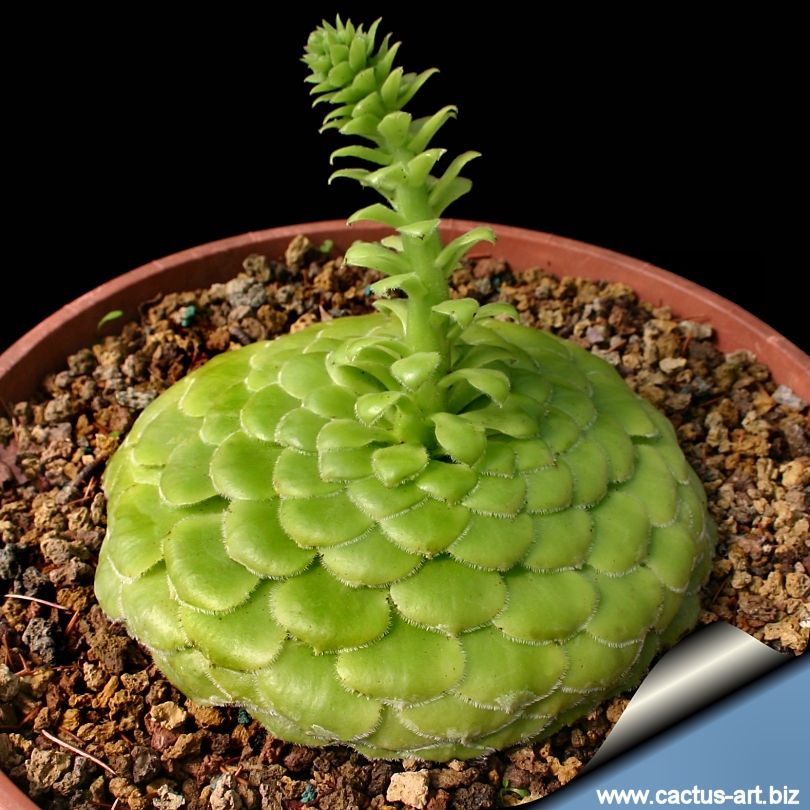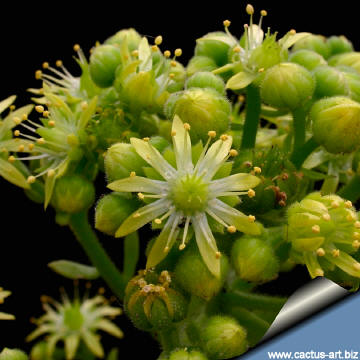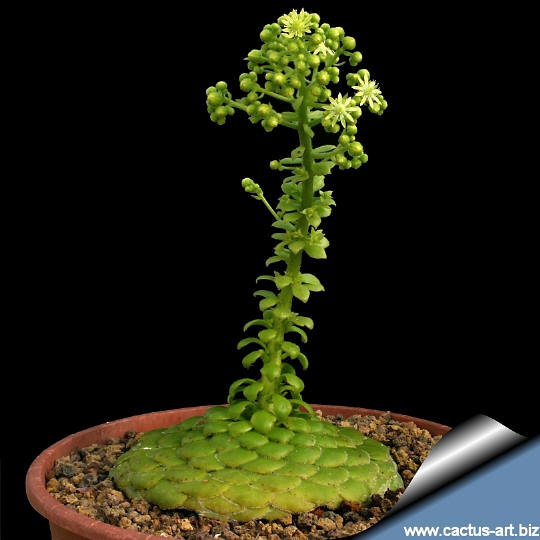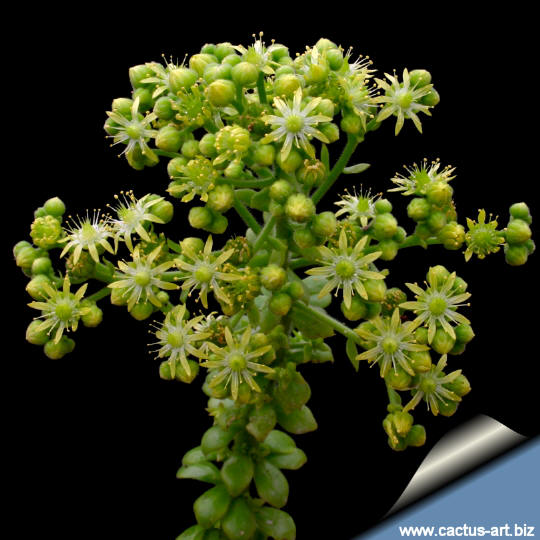|
|
|

A most unusual plant
from the Canary Islands. Individual plants form a perfect flat disc
which can grow to 45 in diameter. This plant is also commonly called
saucer plant. Sometimes, the form will be crested in the center, making
it look like a big green turtle! |
|
 |
Description: Aeonium tabulaeforme is a strange
and wonderful stemless , ground hugging, rosette. Usually single or
offsetting which used to be flat as a pancake. As with most of the
stemless species, this one is
monocarpic.
Leaves: Rounded, soft-green more or less spathulate with long
cilia on the margin. Leaves 3-10(-15) cm long, 2,5-4 cm wide.
Rosette: Usually unbranched formed by 100 to 200 (or more)
closely overlapping leaves held in a swirling pattern. The rosette is
round, flat, only 2-5cm tall but up to 45 cm in diameter.
Flowers: The flower stems is erect, arise from the middle of the
rosette and reaches 50-60 cm of height. It produces many small yellow
flowers. The Aeonium lives about 3 years then dies after blooming.
Blooming season: Late Spring
Sometimes it produces nice crested stems and seems to
to change in and out of its crested mode during the years.
|
|
Cultivation: In temperate regions, Aeoniums
will grow almost all year, only resting a bit during the hottest part of
summer. This easy species is suited for pot culture and prefers light
shade or shade. It needs moderate water in summer, keep dry in winter
Fairly prone to stem root rot do not let water sit on the rosette
crown. Happy in just about any soil type as long as adequate drainage is
provided however pot-grown specimens appreciate rich soil. Hardy only to
-2 degrees C need protection in Winter. Someone suggest to keep it like
in nature (vertical) on the rockwalls. It can be used as a focal point
in a succulent garden or planted in a rock wall. Thrives indoors as a
houseplant too!
Watch the snails they love this plant
.
Reproduction: Seeds, it can also It be propagated by offshoots or
leaf cuttings. Usually the parent plant produces a few pups on the
flowering stalk that is in bloom. If we don't get either seed or pups,
we can try to root individual leaves that are connected to the main
stalk below the 'flower'. In fact we could start to do that before the
main plant starts to decline. This works very well for those Crassula
that stop growing after they have bloomed.
|
|
Photo of conspecific taxa, varieties, forms and cultivars of
Aeonium tabuliforme.
|
|


Advertising
|
|
|
|
Family: Crassulaceae (Stonecrops)
|
|
Scientific name:
Aeonium tabuliforme
D.A. Webb & Berthold
Also spelled "tabulaeforme"
Origin: Canary Islands (from the coastal cliffs on
Tenerife) on several places, Mainly in Teno area, but also at Taganana,
San Juan, Bajamar,
Habitat: These totally flat succulents grows in vertical
cracks in the lava flows on rather steep slopes at around 500 m of
altitude usualy facing the N or N.W. This collocation enabling the
crowns to shed water, effectively preventing rot.
Conservation status: Listed in
CITES appendix 2.
Common Names include: "Saucer plant", "Dinner plate plant"
|
Synonyms:
- Sempervivum complanatum
- Aeonium macrolepum
- Sempervivum tabuliforme
- Aeonium bertoletianum
|
|
|
|

When a plant blooms it starts to change shape, first (about two month
before flowering) it began to look like a shield volcano, and then
begins to look like a Cinder Cone and finally it will sent up a gorgeous
flower stalk, 40-60 cm long. Then the main plant will start to die after
the flowers fade.

|
|